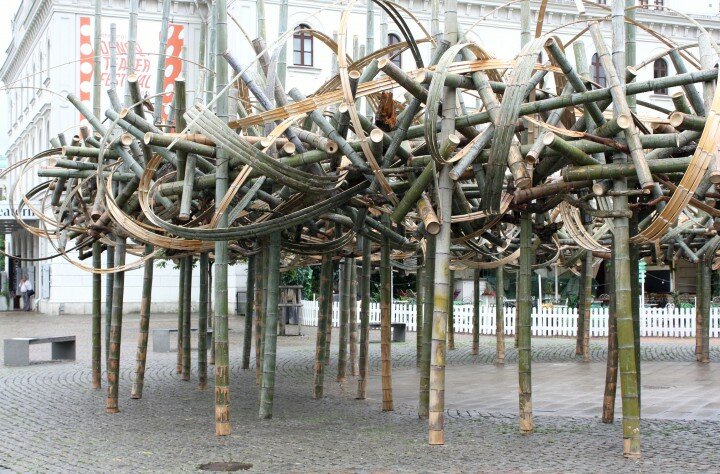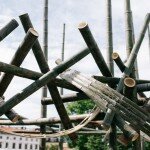Tetsunori Kawana, Japanese installation artist
– I am always listening to the heart-beat of the earth
This summer, Milleniumplatsen square in Gothenburg is transformed into a floating cloud of bamboo!
As a key contributor to Gothenburg Green World 2016, Japanese Installation artist Tetsunori Kawana has been visiting the city. He is known for his giant installations in green bamboo, which he has created all over the world. From 13 June he created a unique installation outside Stora Teatern theatre at Milleniumplatsen. But he did not do it all by himself. He has had help from around thirty volunteers and assistants during the construction work in June.
Kawana’s creations are a collaboration between man and nature at their best. He works with bamboo in an almost magical way, transforming it into something entirely different. He splits it, shreds it, shapes it and gives it new life in quirky three-dimensional structures that are often large enough to walk through. The shapes are swirling, cascading and reminiscent of wind and water. He rotates and twists the material, stretching it to the limits. And he does so in interaction with his co-creators and – not least – the spectator. As a result, his work is just as much a process and a happening. His ability to see plants with fresh eyes extends the concept of garden art and gives it an exciting, contemporary form.
For over thirty years he has been creating installations around the world. In addition to a number of cities in Japan and the USA he has worked in Moscow and Melbourne, Burgo in Italy, and Hong Kong.
KAWANA – on opera stages and at the Olympics.
Kawana has worked as an artist since 1982 and over the years his creativity has taken him to many diverse settings. His work combines the traditional art of ikebana with sculpture, performance art and installation art. In 1992 at the Lyon opera house he created the stage setting for Turandot out of living material, and four years later he repeated the process in Geneva. For the closing ceremony of the winter Olympics in Lillehammer he fashioned a massive installation in tribute to the next Olympics in Nagano. In 1996 he was one of ten artists chosen from around the world to appear at the Arte Sella biennial exhibition in Italy. His work highlights the inherent vitality of all living things – including that of the observer. For more information about Kawana and his earlier work; see his website kawanapassage.com
Nature is the fundamental working material for Kawana:
“I am always listening to the heart-beat of the earth and my creations echo this pulse of nature,” he says in description of his work.
He calls his outdoor installations “Passage”, since they represent physical movement and the movement of time. He sees his installations as passageways or links between man and nature. His work arises in the meeting between the two.
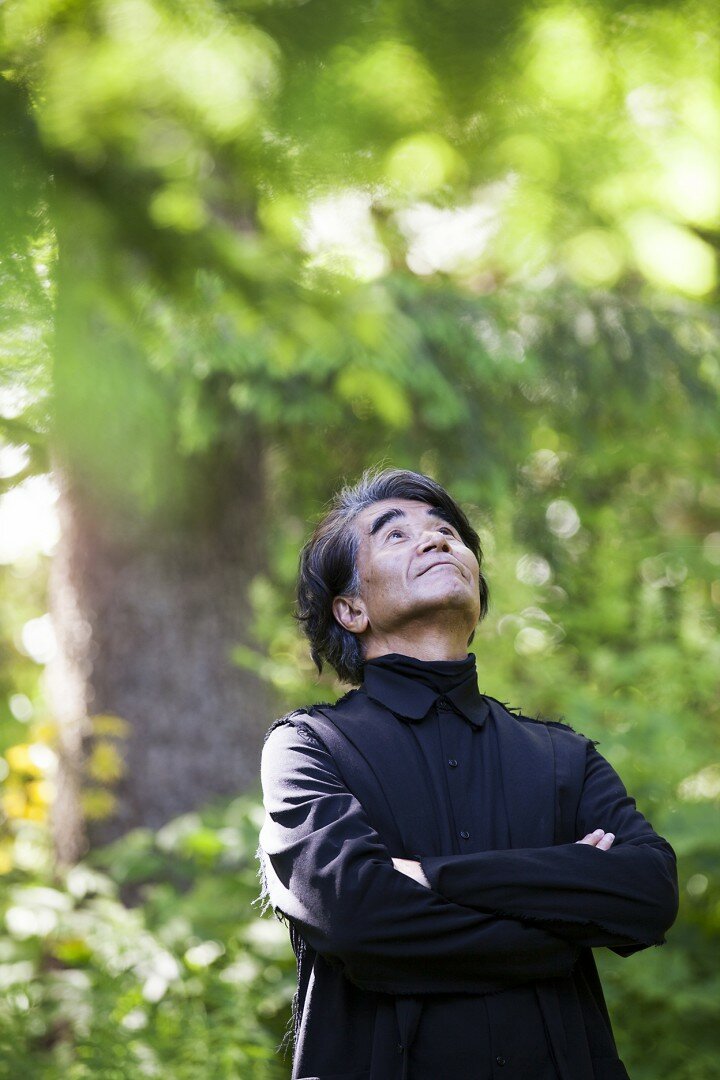
Tetsunori Kawana
“Natural materials exist perfectly well on their own. I am simply their interpreter. Although I really like bamboo in its natural form, I also want to challenge it. Otherwise there would be no point in disturbing it,” he explains.
Each space that Kawana works in has its own context – and gets its own interpretation. He therefore visited Gothenburg early on to inspect the site for the summer installation. At Milleniumplatsen square, flanked by the lively main boulevard Avenyn, Kungsportsbron bridge and Stora Teatern theatre, his vision is of a tranquil, floating cloud. At his disposal he has 400 green bamboo poles, each six metres long and with a diameter of ten centimetres. He pictures his installation as being airy enough to let through the sunlight, so that it too becomes a contributor.
I am always listening to the heart-beat of the earth and my creations echo this pulse of nature.
Kawana’s artistic training lies in ikebana, the Japanese art of flower arranging, and this greatly influences the way he uses his materials – often bamboo. Ikebana is one of the classical art forms of Japan and dates back to the seventh century and the religious custom of placing flowers at the feet of Buddha in temples. Since then it has developed into an independent art form. It has no religious context today, but the Buddhist influences still show in a reverence for the inner vitality of all living things. Ikebana can be translated as “giving life to flowers”. It is a way to understand the inner spirit of nature – without copying it. It is about to seeing and representing something new.
IKEBANA – an art form in the space between humanity and nature
Ikebana has been practised as a spiritual discipline for over a thousand years, among others by the shogun’s samurai and officials in the sixteenth and seventeenth centuries, who also sought refinement in the tea ceremony and calligraphy. Over time, ikebana trickled down to the general public. It is still a central element of Japanese culture and many homes still have flower arrangements. There are many different schools, each with its own masters and conventions. One of the more avant-garde and innovative is the Sogetsu school, founded as recently as 1926 by Sofu Teshigahara. Kawana studied under the founder’s son, Hiroshi Teshigahara, who was the school’s artistic director or “iemoto” from 1980 to 2001, as well as being a well-known and highly regarded film director, ceramicist and calligrapher. Hiroshi Teshigahara introduced bamboo as an artistic medium in ikebana-based sculptures – a heritage that Kawana now builds on with his installations.
Ikebana is not just about arranging flowers. Traditionally it uses quantities of natural materials at all the various stages of life: seed heads, fruits, dried or flowering twigs, moss and so on. Arranging ikebana is not just about seeing what a plant is – but what it can become in the meeting with man. The Sogetsu ikebana style often emphasises the crossing of boundaries and sees ikebana almost as a form of sculpture, but with nature as a base. You can find out more about ikebana and the Sogetsu school on the school’s own website at sogetsu.or.jp/e/know/about
“In my work I use freshly cut, green bamboo. I must respect this bamboo, which has its own life and its own beauty. To succeed, I must communicate with the bamboo and give it new life in my creation, a kind of reincarnation,” he says.
When Kawana works with this material he is just as much interested in its inner qualities. In Japan, bamboo is associated with genuine strength, with the virtues of endurance and resistance to breaking. Kawana highlights this flexibility and endurance when he transforms bamboo poles. Nevertheless it is still bamboo.
BAMBU – deeply rooted in Japanese culture
Bamboo plays a central part in Japanese culture because of the way it combines flexibility with strength. A Japanese proverb says that a storm may fell a massive oak, but bamboo, bent even to the ground, will spring upright after it passes. Bamboo is associated with qualities such as endurance and humility. Throughout the ages it has also been used as a building material, for making utensils and much more. Even today scaffolding is built from strong bamboo poles.
The flexibility and strength of bamboo were demonstrated to the full in 2012 in a Passage that Kawana called “Culture Current”, in Denver, Colorado. Using 850 bamboo poles he created a kind of cultural waterfall of shredded bamboo in which west and east cascade together.
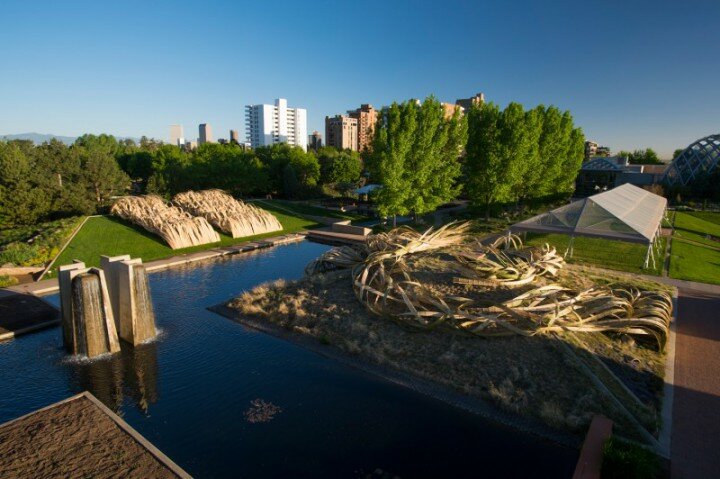
Denver Botanic Gardens, Denver, Colorado,
Photo Scott Dressel-Martin
Bamboo is one of the fastest growing species on earth. Under favourable conditions some varieties can grow up to a metre per day. Bamboo has a wide range of applications. Its tender shoots are a common ingredient in Asian cuisine, and its fibres are also used in textile production to make fabric.
Kawana often uses the Madake variety (Phyllostachys bambusoides) or “Giant Timber Bamboo”, the strongest variety, which has a straight growth habit and can grow up to 20 metres tall.
His latest bamboo installation was “Current”, in Moscow in 2014. This work built on the contrasts between curves and straight lines, lightness and darkness, in a musical interplay with its surroundings. And it seems that he will continue exploring the same material in the future:
“Bamboo is a very environmentally friendly material. It grows to its full height and diameter in only 50 or 60 days. It is mature enough to use in my work after just two years. Wood is different. It takes many years of growth before a tree before is useful.”
But his Passage installations are not created to last; they change with time and after about a year they return to nature. Just like life and beauty, they are transient.
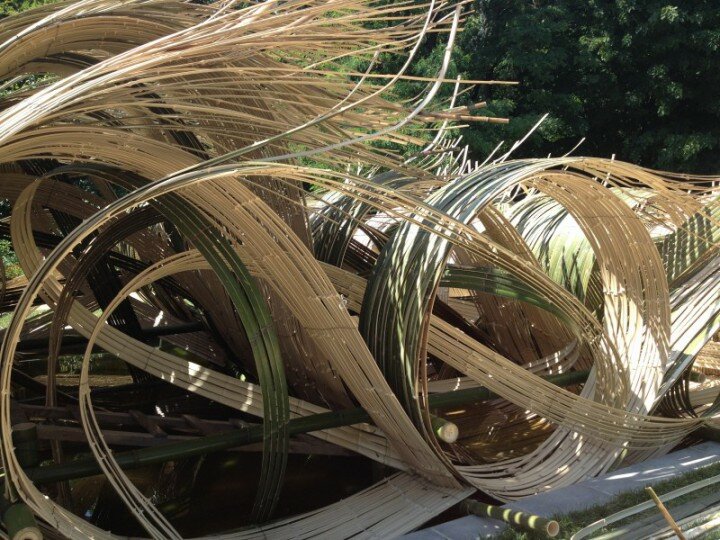
Garden of the Apothecaries, Moscow, Russia
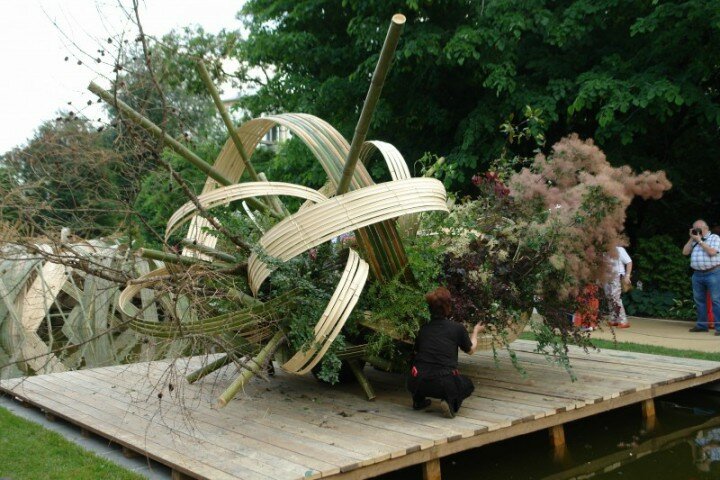
Garden of the Apothecaries, Moscow, Russia
As a seafaring city, Gothenburg has always been open to new influences from the outside world. Kawana’s installation at Milleniumplatsen square has a historical connection with the East India company and the many cargo ships that brought with them fascinating news from East Asia. Now that link is being re-established. Kawana’s Japanese work gives a comtemporary international twist to Gothenburg’s green World.
Photos from the construction work in June
As from October 5, the bamboo installation at Millenniumplatsen Square will be highlighted in cooperation with Göteborg Energi. It will be a beautiful place with nice shadow patterns during the darker period of the year.

